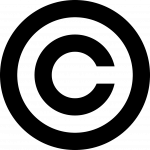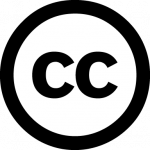4
Before you begin writing, make sure you have a firm grasp of your Authors Rights, Copyright how applying an open-copyright licence — typically a Creative Commons licence [New Tab] — or designating your copyright to the public domain will affect your ownership of your work.
According to the Merriam-Webster dictionary, copyright is
the exclusive, legal right to reproduce, publish, sell, or distribute the matter and form of something (such as a literary, musical, or artistic work)[1]

What is Copyright?
The simplest definition of copyright is a property right given to authors that allows them to control, protect, and exploit their artistic works.
Today it is very easy to receive a copyright for your work. All it needs is to be original, a little creative, and fixed in a tangible medium of expression. So, as soon as you create something, it is probably copyrighted. You don’t need to do anything else; you don’t need to file paperwork with the federal government, pay any fees, publish, or do anything other than create.
Note: The terms copyright and intellectual property are not synonymous. As stated above, copyright are permissions that apply to specific creative works whereas intellectual property is a broad term that refers to
(a) form of creative effort that can be protected through a trademark, patent, copyright, industrial design or integrated circuit topography.[2]
A bundle of rights
Rather than being one right, it might be best to think of copyright as a bundle of rights which authors have over their artistic works. Those rights are:
- right to reproduce
- right to make derivative works
- right to distribute copies of a work
- right to perform a work publicly
- right to display a work publicly
- for sound recordings, the right to perform the work by digital audio transmission
As a creator, you can give your whole copyright away, or you can allow others to use some or all of these rights through licenses. The choice is yours.
Authors” Rights: Who owns a copyright? You are the Owner until you give your Copyright away!
The default rule is that authors own the copyrights to their works as soon as they create them. Like so much in the law, however, there are several instances where ownership is not so simple. Joint authors, for instance, both own the whole work together, instead of each person owning the part they create. What is more, if employees create works that are within the scope of their jobs, the copyrights are owned by the employers as “works-for-hire.”
Additionally, the law permits copyright owners to transfer their copyrights in whole or in part to other people, as well as allow others to use their works while retaining copyrights ownership through licenses.
Furthermore, the law specifically allows people to transfer their copyrights in part or in whole. Note: a transfer of copyright ownership is not valid unless it is in writing and signed by the owner. —17 U.S.C. §§ 101, 201 – 205
By default, the creator of a work (its author) owns the copyright in the work. A major exception to this is that an employer generally owns the copyright in works created by its employees, though the Claremont Colleges and most other universities allow employees to keep the copyright in certain scholarly and creative work: you should always have a conversation about who owns the work and how you will proceed with copyright.
A scholarly publisher will therefore often ask for the author’s permission in order to publish their work. Some publication agreements require you to assign your entire copyright over to the publisher in exchange for publishing your work. This means that, upon signing such an agreement, you will lose all control over your work in exchange for publication. Your work would then belong to the publisher.
However, publishers do not actually need to own a copyright to publish an article. Instead, they only need certain rights to distribute the work. As the author, you can to negotiate to keep your copyright and instead give the publisher a non-exclusive license to distribute the work.
In deciding whether or not you are willing to transfer your entire copyright to a publisher, consider what you want to do with your work besides have it published. Retaining ownership of the copyright ensures that you will be able to do all of the following without constraints:
Open-copyright licences

Creative Commons (CC) licences are open-copyright licences. (Also referred to as copyright licences.) Unlike more restrictive licences or permissions, these set of licences grant the following permissions and conditions. They give:
- the non-exclusive right
- to anyone
- anywhere on the globe
- to retain, reuse, redistribute, remix, or revise
- the author’s copyrighted work
- as many times as they like
- with no expiration date on these permissions.
The only condition to these permissions is that the user must attribute — give credit to — the copyright holder or the creator of the work. This is the minimal requirement of the most basic Creative Commons Attribution (also called CC BY) licence. Other versions of this open-copyright licence may include additional conditions. (See Appendix 1: Licences and Tools.)
The 5Rs of Openness
In his 2007 blog, David Wiley described the “Four Rs of Open Content”[3].

This was followed seven years later by the fifth R.[4] The elegant simplicity of these five statements has grabbed the attention of open educators everywhere and has become a standard and easy-to-remember method for describing how open licences work. The five Rs are:
- Retain: the right to make, own, and control copies of the content
- Reuse: the right to use the content in a wide range of ways, e.g., in a class, in a study group, on a website, in a video
- Revise: the right to adapt, adjust, modify, or alter the content itself, e.g., translate the content into another language
- Remix: the right to combine the original or revised content with other open content to create something new, e.g., incorporate the content into a mashup
- Redistribute: the right to share copies of the original content, your revisions, or your remixes with others, e.g., give a copy of the content to a friend
Avoid copyright infringement
It is the responsibility of the open textbook author to ensure that all material in an open textbook — whether it be newly created or modified, such as images, data, or multimedia — does not infringe or induce the infringement of any third-party copyrights.
For more information, read How to Avoid Copyright Infringement [New Tab].
The Digital Copyright Slider [New Tab] is tool that can be used to establish if works first published in the U.S. are still protected by copyright (in the U.S.) or in the public domain.
For individual assistance and specific questions, consult with an intellectual property/copyright expert at your institution or elsewhere.
Attributions
David Wiley by Celine Morton is used under a CC BY 2.0 Licence.
- "copyright," Merriam-Webster, https://www.merriam-webster.com/dictionary/copyright (accessed August 1, 2017). ↵
- "Glossary of Intellectual Property Terms," Government of Canada, https://www.ic.gc.ca/eic/site/cipointernet-internetopic.nsf/eng/wr00837.html#i (accessed November 16, 2017). ↵
- David Wiley, Weblog entry on "Open Education License Draft," iterating toward openness, posted August 8, 2007, https://opencontent.org/blog/archives/355 (accessed December 13, 2017). ↵
- David Wiley, Weblog entry on "The Access Compromise and the 5th R," iterating toward openness, posted March 5, 2014, https://opencontent.org/blog/archives/3221 (accessed December 13, 2017). ↵

